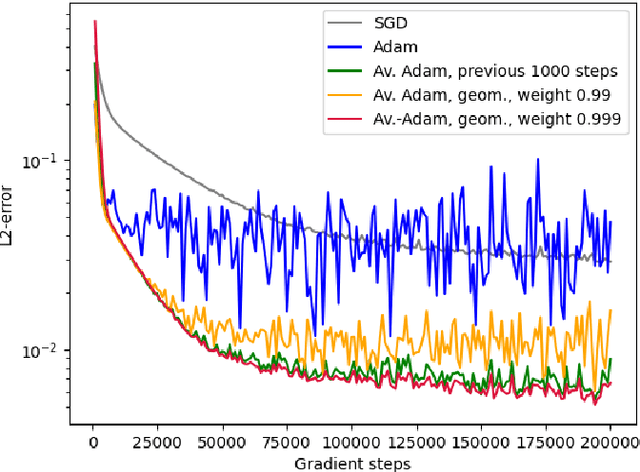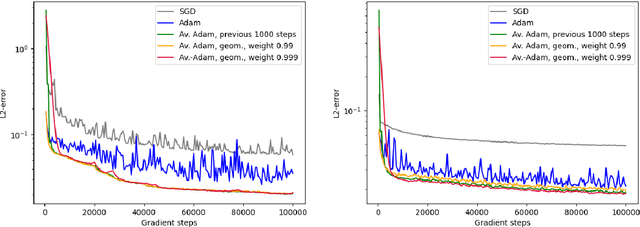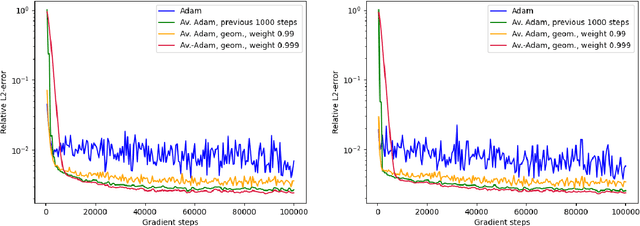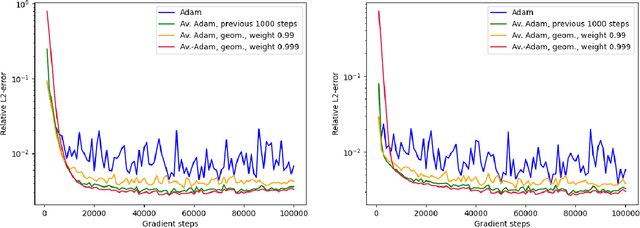Steffen Dereich
SAD Neural Networks: Divergent Gradient Flows and Asymptotic Optimality via o-minimal Structures
May 14, 2025Abstract:We study gradient flows for loss landscapes of fully connected feed forward neural networks with commonly used continuously differentiable activation functions such as the logistic, hyperbolic tangent, softplus or GELU function. We prove that the gradient flow either converges to a critical point or diverges to infinity while the loss converges to an asymptotic critical value. Moreover, we prove the existence of a threshold $\varepsilon>0$ such that the loss value of any gradient flow initialized at most $\varepsilon$ above the optimal level converges to it. For polynomial target functions and sufficiently big architecture and data set, we prove that the optimal loss value is zero and can only be realized asymptotically. From this setting, we deduce our main result that any gradient flow with sufficiently good initialization diverges to infinity. Our proof heavily relies on the geometry of o-minimal structures. We confirm these theoretical findings with numerical experiments and extend our investigation to real-world scenarios, where we observe an analogous behavior.
Sharp higher order convergence rates for the Adam optimizer
Apr 28, 2025Abstract:Gradient descent based optimization methods are the methods of choice to train deep neural networks in machine learning. Beyond the standard gradient descent method, also suitable modified variants of standard gradient descent involving acceleration techniques such as the momentum method and/or adaptivity techniques such as the RMSprop method are frequently considered optimization methods. These days the most popular of such sophisticated optimization schemes is presumably the Adam optimizer that has been proposed in 2014 by Kingma and Ba. A highly relevant topic of research is to investigate the speed of convergence of such optimization methods. In particular, in 1964 Polyak showed that the standard gradient descent method converges in a neighborhood of a strict local minimizer with rate (x - 1)(x + 1)^{-1} while momentum achieves the (optimal) strictly faster convergence rate (\sqrt{x} - 1)(\sqrt{x} + 1)^{-1} where x \in (1,\infty) is the condition number (the ratio of the largest and the smallest eigenvalue) of the Hessian of the objective function at the local minimizer. It is the key contribution of this work to reveal that Adam also converges with the strictly faster convergence rate (\sqrt{x} - 1)(\sqrt{x} + 1)^{-1} while RMSprop only converges with the convergence rate (x - 1)(x + 1)^{-1}.
In almost all shallow analytic neural network optimization landscapes, efficient minimizers have strongly convex neighborhoods
Apr 11, 2025Abstract:Whether or not a local minimum of a cost function has a strongly convex neighborhood greatly influences the asymptotic convergence rate of optimizers. In this article, we rigorously analyze the prevalence of this property for the mean squared error induced by shallow, 1-hidden layer neural networks with analytic activation functions when applied to regression problems. The parameter space is divided into two domains: the 'efficient domain' (all parameters for which the respective realization function cannot be generated by a network having a smaller number of neurons) and the 'redundant domain' (the remaining parameters). In almost all regression problems on the efficient domain the optimization landscape only features local minima that are strongly convex. Formally, we will show that for certain randomly picked regression problems the optimization landscape is almost surely a Morse function on the efficient domain. The redundant domain has significantly smaller dimension than the efficient domain and on this domain, potential local minima are never isolated.
Mathematical analysis of the gradients in deep learning
Jan 26, 2025Abstract:Deep learning algorithms -- typically consisting of a class of deep artificial neural networks (ANNs) trained by a stochastic gradient descent (SGD) optimization method -- are nowadays an integral part in many areas of science, industry, and also our day to day life. Roughly speaking, in their most basic form, ANNs can be regarded as functions that consist of a series of compositions of affine-linear functions with multidimensional versions of so-called activation functions. One of the most popular of such activation functions is the rectified linear unit (ReLU) function $\mathbb{R} \ni x \mapsto \max\{ x, 0 \} \in \mathbb{R}$. The ReLU function is, however, not differentiable and, typically, this lack of regularity transfers to the cost function of the supervised learning problem under consideration. Regardless of this lack of differentiability issue, deep learning practioners apply SGD methods based on suitably generalized gradients in standard deep learning libraries like {\sc TensorFlow} or {\sc Pytorch}. In this work we reveal an accurate and concise mathematical description of such generalized gradients in the training of deep fully-connected feedforward ANNs and we also study the resulting generalized gradient function analytically. Specifically, we provide an appropriate approximation procedure that uniquely describes the generalized gradient function, we prove that the generalized gradients are limiting Fr\'echet subgradients of the cost functional, and we conclude that the generalized gradients must coincide with the standard gradient of the cost functional on every open sets on which the cost functional is continuously differentiable.
Averaged Adam accelerates stochastic optimization in the training of deep neural network approximations for partial differential equation and optimal control problems
Jan 10, 2025



Abstract:Deep learning methods - usually consisting of a class of deep neural networks (DNNs) trained by a stochastic gradient descent (SGD) optimization method - are nowadays omnipresent in data-driven learning problems as well as in scientific computing tasks such as optimal control (OC) and partial differential equation (PDE) problems. In practically relevant learning tasks, often not the plain-vanilla standard SGD optimization method is employed to train the considered class of DNNs but instead more sophisticated adaptive and accelerated variants of the standard SGD method such as the popular Adam optimizer are used. Inspired by the classical Polyak-Ruppert averaging approach, in this work we apply averaged variants of the Adam optimizer to train DNNs to approximately solve exemplary scientific computing problems in the form of PDEs and OC problems. We test the averaged variants of Adam in a series of learning problems including physics-informed neural network (PINN), deep backward stochastic differential equation (deep BSDE), and deep Kolmogorov approximations for PDEs (such as heat, Black-Scholes, Burgers, and Allen-Cahn PDEs), including DNN approximations for OC problems, and including DNN approximations for image classification problems (ResNet for CIFAR-10). In each of the numerical examples the employed averaged variants of Adam outperform the standard Adam and the standard SGD optimizers, particularly, in the situation of the scientific machine learning problems. The Python source codes for the numerical experiments associated to this work can be found on GitHub at https://github.com/deeplearningmethods/averaged-adam.
Convergence rates for the Adam optimizer
Jul 29, 2024Abstract:Stochastic gradient descent (SGD) optimization methods are nowadays the method of choice for the training of deep neural networks (DNNs) in artificial intelligence systems. In practically relevant training problems, usually not the plain vanilla standard SGD method is the employed optimization scheme but instead suitably accelerated and adaptive SGD optimization methods are applied. As of today, maybe the most popular variant of such accelerated and adaptive SGD optimization methods is the famous Adam optimizer proposed by Kingma & Ba in 2014. Despite the popularity of the Adam optimizer in implementations, it remained an open problem of research to provide a convergence analysis for the Adam optimizer even in the situation of simple quadratic stochastic optimization problems where the objective function (the function one intends to minimize) is strongly convex. In this work we solve this problem by establishing optimal convergence rates for the Adam optimizer for a large class of stochastic optimization problems, in particular, covering simple quadratic stochastic optimization problems. The key ingredient of our convergence analysis is a new vector field function which we propose to refer to as the Adam vector field. This Adam vector field accurately describes the macroscopic behaviour of the Adam optimization process but differs from the negative gradient of the objective function (the function we intend to minimize) of the considered stochastic optimization problem. In particular, our convergence analysis reveals that the Adam optimizer does typically not converge to critical points of the objective function (zeros of the gradient of the objective function) of the considered optimization problem but converges with rates to zeros of this Adam vector field.
Non-convergence of Adam and other adaptive stochastic gradient descent optimization methods for non-vanishing learning rates
Jul 11, 2024Abstract:Deep learning algorithms - typically consisting of a class of deep neural networks trained by a stochastic gradient descent (SGD) optimization method - are nowadays the key ingredients in many artificial intelligence (AI) systems and have revolutionized our ways of working and living in modern societies. For example, SGD methods are used to train powerful large language models (LLMs) such as versions of ChatGPT and Gemini, SGD methods are employed to create successful generative AI based text-to-image creation models such as Midjourney, DALL-E, and Stable Diffusion, but SGD methods are also used to train DNNs to approximately solve scientific models such as partial differential equation (PDE) models from physics and biology and optimal control and stopping problems from engineering. It is known that the plain vanilla standard SGD method fails to converge even in the situation of several convex optimization problems if the learning rates are bounded away from zero. However, in many practical relevant training scenarios, often not the plain vanilla standard SGD method but instead adaptive SGD methods such as the RMSprop and the Adam optimizers, in which the learning rates are modified adaptively during the training process, are employed. This naturally rises the question whether such adaptive optimizers, in which the learning rates are modified adaptively during the training process, do converge in the situation of non-vanishing learning rates. In this work we answer this question negatively by proving that adaptive SGD methods such as the popular Adam optimizer fail to converge to any possible random limit point if the learning rates are asymptotically bounded away from zero. In our proof of this non-convergence result we establish suitable pathwise a priori bounds for a class of accelerated and adaptive SGD methods, which are also of independent interest.
Learning rate adaptive stochastic gradient descent optimization methods: numerical simulations for deep learning methods for partial differential equations and convergence analyses
Jun 20, 2024



Abstract:It is known that the standard stochastic gradient descent (SGD) optimization method, as well as accelerated and adaptive SGD optimization methods such as the Adam optimizer fail to converge if the learning rates do not converge to zero (as, for example, in the situation of constant learning rates). Numerical simulations often use human-tuned deterministic learning rate schedules or small constant learning rates. The default learning rate schedules for SGD optimization methods in machine learning implementation frameworks such as TensorFlow and Pytorch are constant learning rates. In this work we propose and study a learning-rate-adaptive approach for SGD optimization methods in which the learning rate is adjusted based on empirical estimates for the values of the objective function of the considered optimization problem (the function that one intends to minimize). In particular, we propose a learning-rate-adaptive variant of the Adam optimizer and implement it in case of several neural network learning problems, particularly, in the context of deep learning approximation methods for partial differential equations such as deep Kolmogorov methods, physics-informed neural networks, and deep Ritz methods. In each of the presented learning problems the proposed learning-rate-adaptive variant of the Adam optimizer faster reduces the value of the objective function than the Adam optimizer with the default learning rate. For a simple class of quadratic minimization problems we also rigorously prove that a learning-rate-adaptive variant of the SGD optimization method converges to the minimizer of the considered minimization problem. Our convergence proof is based on an analysis of the laws of invariant measures of the SGD method as well as on a more general convergence analysis for SGD with random but predictable learning rates which we develop in this work.
On the existence of optimal shallow feedforward networks with ReLU activation
Mar 06, 2023Abstract:We prove existence of global minima in the loss landscape for the approximation of continuous target functions using shallow feedforward artificial neural networks with ReLU activation. This property is one of the fundamental artifacts separating ReLU from other commonly used activation functions. We propose a kind of closure of the search space so that in the extended space minimizers exist. In a second step, we show under mild assumptions that the newly added functions in the extension perform worse than appropriate representable ReLU networks. This then implies that the optimal response in the extended target space is indeed the response of a ReLU network.
On the existence of minimizers in shallow residual ReLU neural network optimization landscapes
Feb 28, 2023Abstract:Many mathematical convergence results for gradient descent (GD) based algorithms employ the assumption that the GD process is (almost surely) bounded and, also in concrete numerical simulations, divergence of the GD process may slow down, or even completely rule out, convergence of the error function. In practical relevant learning problems, it thus seems to be advisable to design the ANN architectures in a way so that GD optimization processes remain bounded. The property of the boundedness of GD processes for a given learning problem seems, however, to be closely related to the existence of minimizers in the optimization landscape and, in particular, GD trajectories may escape to infinity if the infimum of the error function (objective function) is not attained in the optimization landscape. This naturally raises the question of the existence of minimizers in the optimization landscape and, in the situation of shallow residual ANNs with multi-dimensional input layers and multi-dimensional hidden layers with the ReLU activation, the main result of this work answers this question affirmatively for a general class of loss functions and all continuous target functions. In our proof of this statement, we propose a kind of closure of the search space, where the limits are called generalized responses, and, thereafter, we provide sufficient criteria for the loss function and the underlying probability distribution which ensure that all additional artificial generalized responses are suboptimal which finally allows us to conclude the existence of minimizers in the optimization landscape.
 Add to Chrome
Add to Chrome Add to Firefox
Add to Firefox Add to Edge
Add to Edge